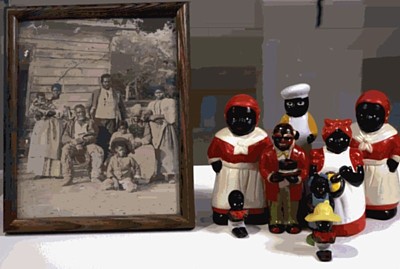
(the above image is a piece by the artist Fred Wilson, entitled "mine/yours.")
i'm in the middle of trying to make major headway on two book projects that are under contract and due in the next few months. both are collaborations with multiple other people, which is great but also hard. collaboration is hard! also writing books is hard. and both are also attempts to bring strong but inaccessible historical thinking into contact with strong ideas about pedagogy and classroom practice.
the one i'm deepest in the middle of at this precise moment is a book about the idea and practice of using contemporary art to teach history in the secondary social studies classroom-- a topic that, remarkably, hasn't really been explored in depth anywhere else to date. its a great project, and i've been working with my collaborators on it for years, and we have a good structure, but i'm coming up against what is often a problem in this kind of cross-disciplinary ginormous type of endeavor: how to boil things down? how to pick a central historical question and idea from the fifteen or so that seem important in any given chapter, and how to make sure its THE one that best suits the artwork and the pedagogical purpose? its really challenging. also: how to keep the ideas at a high level without losing the readers, without writing incomprehensibly? how to address both complicated historical questions and the practical and pedagogical concerns of classroom teachers? these are questions that i am contemplating.
and in specific, i'm contemplating the question of how to do this in a chapter that's specifically about the history of race, and through the lenses of slavery & abolition, and immigration. there are obvious ways to do this, and that's why we (I) put them all together in a chapter on the history of race, but its also SO MUCH MATERIAL to choose from-- in addition to the other concerns i mentioned above. plus we're keeping the whole project primary document-based...and etc.
on a positive note: i'm very excited about the project, and this chapter in particular is really getting me jazzed-- especially the task of publishing and thinking about structures for talking about the primary documents i'm working with, some of which i don't think have been published in teacher-oriented texts ever before, and some of which are gaining new meaning in light of the works of contemporary art with which we're pairing them. for instance the image at the top of this post, by Fred Wilson, is, i think, just so provocative, and really invites a very distinct conversation about racial identity and the way that US Americans remember slavery than you could get from a historical monograph. Of these two representations of a family of enslaved people, Wilson's piece asks, which is "yours?" which is "mine?" more importantly, it seems he's making a statement about the way that slavery is officially remembered in the US, versus, perhaps, how African Americans remember/understand it.
Its not just Fred Wilson, either. There are quite a number of genius contemporary artists grappling with important historical questions. and these artists offer, on the one hand, fresh kinds of critical historical analysis. although most historians wouldn't recognize them as such, these sorts of artworks really are also works of historical analysis (in visual form) in and of themselves. also many of the pieces that we've found open up unusual doorways for thinking about classroom activities and models of learning and writing and thinking. its exciting to think about putting this material (and guides for how to think about and use it in a classroom context) into the hands of educators.
alright, back to work... more soon...





No comments:
Post a Comment